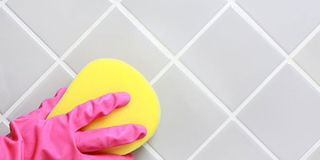Here’s how you can keep your tiles clean

Always opt for a soft cleaning cloth or brush. Hard/brittle brushes leave scratch marks on the tiles. Photo/learn.compactappliance.com
What you need to know:
Tiles, although they brighten up what would otherwise be a plain and dull space are susceptible to dirt from many substances. So what is the right way to clean tiles and still have them looking new and shiny?
Marie Kondo, a renowned Japanese home organising consultant and author always says, “The objective of cleaning is not just to clean, but to feel happy living in that environment,” It is no surprise then that keeping your floor and wall tiles spotless will not only add spark to your home but also make it more inviting.
In the kitchen area, it is inevitable for tiles to have food stains, in the bathroom, soap stains usually build up there not to mention the floor tiles that are home to dust, mud, food and drinks spills. Sometimes simply putting water and mop to tiles leaves them looking hazy and discoloured. Some cleaning tools even cause scratches.
So what is the right way to clean tiles?
Interior designer Ms Sheila Nakitende says taking care of tiles requires daily cleaning.
“You have to sweep them first, (or use a vacuum cleaner) so that when you mop, the dust doesn’t stain the tiles,” Nakitende says.
Liquid Soap
She recommends use of liquid soap added to the clean water but that one round of mopping will not give you the cleanliness you desire.
“You must clean them twice. The first time, add liquid soap to the water, the second time, simply use clear water without soap. This helps not only attain a cleaner effect but also help remove the soap from the tiles that could stain them and even cause slipping,”
Home care and real estate online platform, www.diynetwork.com, differs with Nakitende’s view. They say cleaning need not be daily but only a couple of times a week.
Cleaning tools to use
Mr Kyle Duncan Kushaba, director Kyle Cleaning & Fumigation Services Limited, recommends the use of a soft brushes over those with harder spikes, arguing that the latter might wear out tiles faster than intended. He also advises that one chooses the type of detergent to use carefully.
“You may clean everyday but fail to achieve the cleanliness you want so it is important that you research on what kind of tile detergent to use. Once you have that in check, everything else should be easy,” he explains.
Use a detergent that does not cause the tile colour to fade or one that does not leave scratch marks. Before buying a detergent, read up on its contents to be sure it will not damage your tiles. Always look out for non-abrasive cleaners.
Homemade cleaning tricks Cleaning experts recommend lemon juice or vinegar with hot water mixture. Apply it to the floor and then use a towel/ clean cloth that you push over the floor with your foot.
Author Shelley Marie writes on the Home Guides blog recommending vinegar as a natural, non-toxic product that safely deodorizes, disinfects and cleans most hard surfaces.
“When your porcelain or tile floors become soiled, vinegar can effectively clean them without harsh fumes.
White vinegar is a mild acid that works especially well to dissolve grease and hard water stains. Once the vinegar dries, it leaves behind a fresh, neutral scent. You can customise the scent by mixing a few drops of your favourite essential oils into the vinegar solution before cleaning,” she explains.
And it is a mix you can achieve by mixing half a cup of white vinegar with one gallon of warm water in a bucket. She cautions that it is advisable to open windows or ventilate the area if the smell of vinegar bothers you.
Nakitende uses liquid soap. She says use of clean water will get the tiles shinning, adding that it will help remove rug marks that would stain the tiles over time.
Baking soda
For stubborn grout stains, mix water and baking soda to achieve a paste.
Apply the paste on the stained tiles and let it sit for a couple or more hours.
Scrub the tiles with a soft brush/sponge and wash with clean water.




